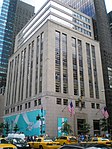Silent Parade
1917 in New York City1917 protestsAfrican-American history between emancipation and the civil rights movementAfrican-American history in New York CityCivil rights protests in the United States ... and 6 more
History of African-American civil rightsJuly 1917 eventsLynching in the United StatesProtest marches in New York CityRacially motivated violence against African AmericansUnited States home front during World War I

The Negro Silent Protest Parade, commonly known as the Silent Parade, was a silent march of about 10,000 African Americans along Fifth Avenue starting at 57th Street in New York City on July 28, 1917. The event was organized by the NAACP, church, and community leaders to protest violence directed towards African Americans, such as recent lynchings in Waco and Memphis. The parade was precipitated by the East St. Louis riots in May and July 1917 where at least 40 black people were killed by white mobs, in part touched off by a labor dispute where blacks were used for strike breaking.
Excerpt from the Wikipedia article Silent Parade (License: CC BY-SA 3.0, Authors, Images).Silent Parade
5th Avenue, New York Manhattan
Geographical coordinates (GPS) Address Nearby Places Show on map
Geographical coordinates (GPS)
| Latitude | Longitude |
|---|---|
| N 40.763055555556 ° | E -73.973888888889 ° |
Address
5th Avenue 737
10022 New York, Manhattan
New York, United States
Open on Google Maps







